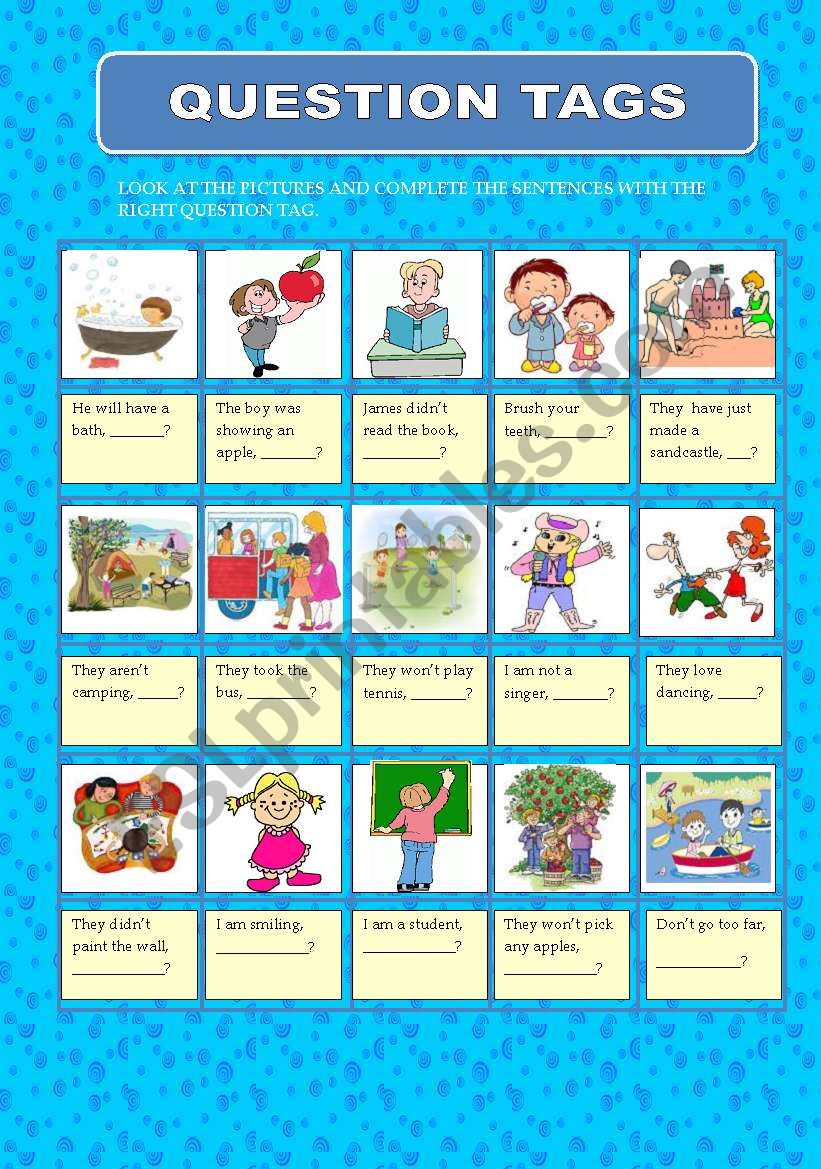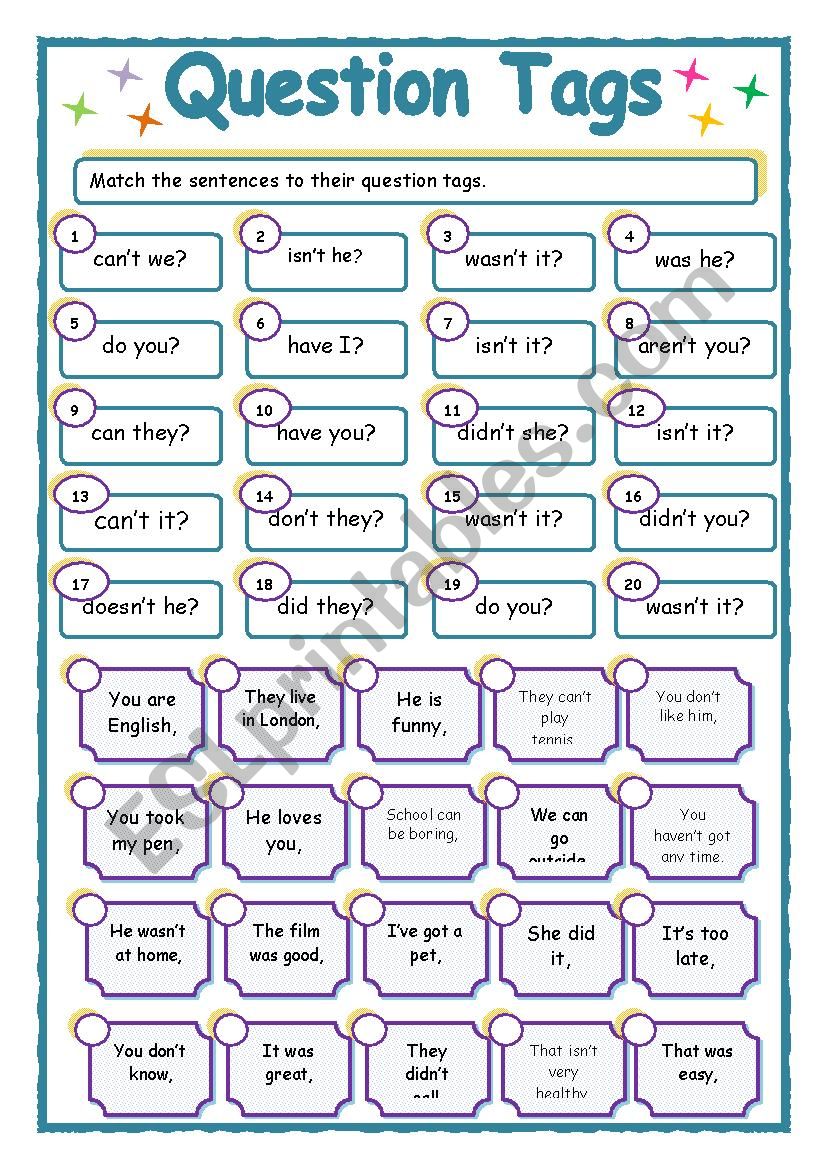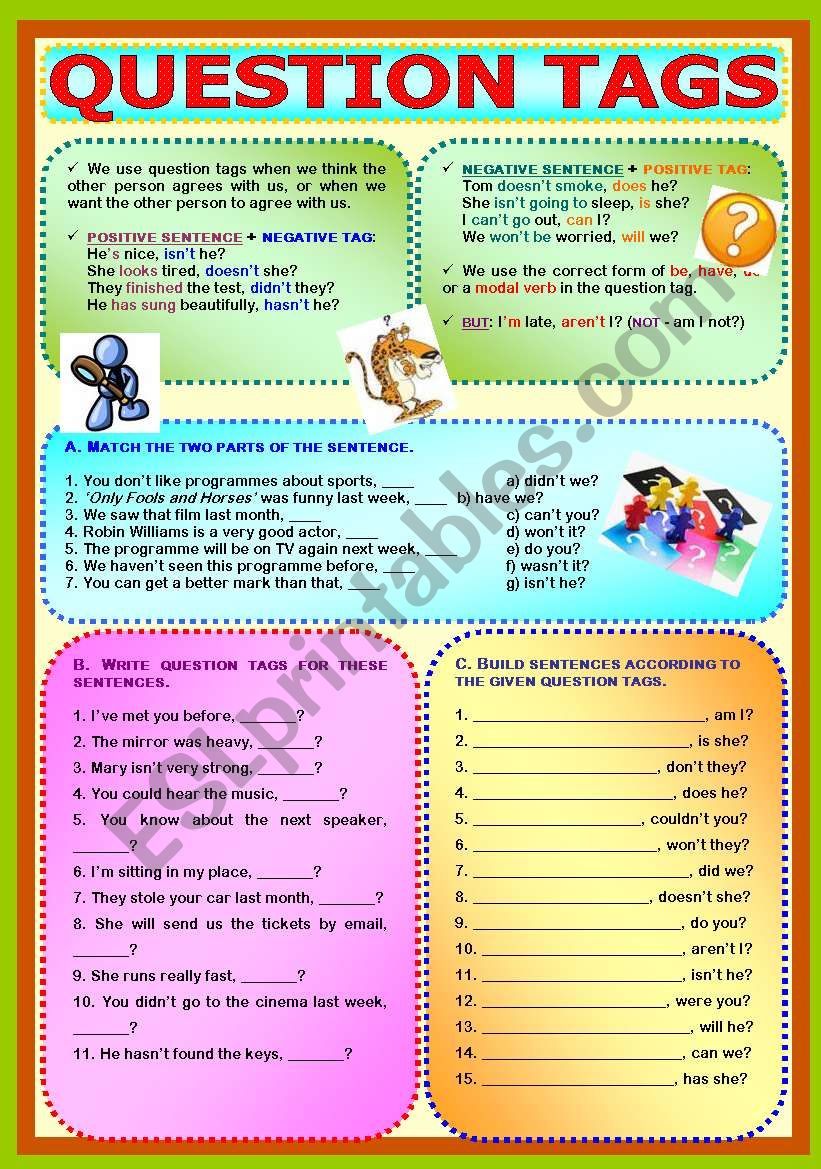
Mastering Conversational English: The Indispensable Role of Question Tags Worksheets
English, a language of immense global reach, is replete with nuances that often challenge even advanced learners. Among these, question tags stand out as a particularly fascinating and frequently misunderstood grammatical construct. These short questions, appended to the end of a statement, serve a multitude of purposes: seeking confirmation, inviting agreement, or simply adding a conversational flourish. While seemingly straightforward, mastering their correct usage—in terms of auxiliary verbs, pronouns, and even intonation—requires dedicated practice. This is precisely where Question Tags Worksheets prove to be an invaluable resource, providing structured, repetitive, and varied exercises essential for true mastery.
The Anatomy and Purpose of Question Tags
At its core, a question tag is formed by an auxiliary verb (or a form of "to be") and a pronoun, mirroring the subject and verb of the main statement. The fundamental rule is inversion: if the main statement is positive, the tag is negative; if the statement is negative, the tag is positive.

- She is a doctor, isn’t she? (Positive statement, negative tag)
- They haven’t arrived yet, have they? (Negative statement, positive tag)




Beyond this basic structure, question tags add a layer of sophistication to English communication. They are not merely grammatical footnotes but powerful tools for:
- Confirmation: To check if information is correct (You live in London, don’t you?).
- Seeking Agreement: To invite the listener to concur with a statement (It’s a beautiful day, isn’t it?).
- Encouraging Conversation: To keep a dialogue flowing, especially in informal settings.
- Expressing Doubt or Certainty: The intonation—rising for doubt, falling for certainty—can significantly alter the meaning.


Given their widespread use in everyday conversation, news broadcasts, and even formal speeches, an inability to use question tags correctly can lead to misunderstandings or make one’s English sound unnatural. This highlights the critical need for targeted practice, which Question Tags Worksheets are perfectly designed to provide.
Why Question Tags Worksheets Are Indispensable for Learning

Learning a grammatical concept involves more than just memorizing rules; it requires active application. Worksheets offer a structured environment for this application, transforming abstract rules into practical exercises. For question tags, specifically, worksheets provide several key benefits:
- Systematic Practice: They allow learners to practice various scenarios repeatedly, solidifying the rules through muscle memory.
- Identification of Common Errors: Worksheets often include exercises designed to target typical mistakes, such as mismatched tenses or incorrect auxiliary verbs.
- Exposure to Diverse Contexts: Good worksheets present question tags within different sentence structures and thematic contexts, helping learners understand their versatility.
- Self-Assessment: With answer keys, learners can immediately check their understanding and identify areas needing more attention.
- Gradual Progression: Many worksheets are designed with increasing levels of difficulty, starting with basic structures and moving to more complex and irregular cases.

The Intricacies: Rules and Special Cases Addressed in Worksheets
While the positive-negative inversion is the core rule, question tags are rife with exceptions and specific constructions that often trip up learners. Comprehensive Question Tags Worksheets delve into these intricacies, ensuring a holistic understanding.
1. Auxiliary Verbs and Tenses:
The auxiliary verb in the tag must match the auxiliary verb and tense of the main statement.
- She can swim, can’t she? (Modal auxiliary)
- He has finished, hasn’t he? (Present perfect auxiliary)
- They did not go, did they? (Past simple auxiliary)
- You will come, won’t you? (Future simple auxiliary)
2. Statements without Auxiliary Verbs (Simple Present/Past):
For simple present and simple past tenses without an explicit auxiliary, "do/does" (present) or "did" (past) are used in the tag.
- You like coffee, don’t you?
- She speaks French, doesn’t she?
- They went to the party, didn’t they?
3. The Peculiar "I am":
One of the most famous exceptions is the tag for "I am," which is "aren’t I?"
- I am late, aren’t I? (Note: "amn’t I" is archaic or dialectal)
4. Imperatives:
When a statement is an imperative (a command or request), the tag usually uses "will you" or "won’t you."
- Close the door, will you?
- Don’t forget, will you?
5. "Let’s":
For suggestions starting with "Let’s," the tag is always "shall we?"
- Let’s go to the cinema, shall we?
6. Indefinite Pronouns:
When the subject is an indefinite pronoun like "everyone," "nobody," "someone," etc., the pronoun in the tag is "they."
- Everyone has arrived, haven’t they?
- Nobody called, did they?
7. Statements with Negative Words:
If the main statement contains a word that carries a negative meaning (e.g., never, hardly, scarcely, rarely, seldom), the statement is treated as negative, and the tag is positive.
- She hardly ever eats meat, does she?
- They rarely visit, do they?
8. "There is/are":
When a statement begins with "There is/are," the tag uses "there."
- There is a problem, isn’t there?
- There aren’t any left, are there?
Effective Question Tags Worksheets provide targeted exercises for each of these rules and exceptions, often with examples and clear explanations.
What Makes a Great Question Tags Worksheet?
Not all worksheets are created equal. A truly effective Question Tags Worksheet should possess several key characteristics:
- Clear Instructions: Unambiguous directions are crucial, especially for self-study.
- Varied Exercise Types: Beyond simple fill-in-the-blanks, look for:
- Matching exercises: Connecting statements to their correct tags.
- Sentence completion: Providing the statement and asking for the tag.
- Dialogue completion: Integrating question tags into short conversations.
- Error correction: Identifying and correcting mistakes in given sentences.
- Transformation exercises: Changing statements into questions with tags.
- Contextualized scenarios: Using question tags in realistic situations.
- Progressive Difficulty: Starting with easier concepts and gradually introducing more complex rules and exceptions.
- Sufficient Practice: Enough examples to reinforce each rule without becoming overly repetitive or tedious.
- Answer Key: Essential for self-correction and immediate feedback.
- Focus on Intonation (implied): While text-based, good worksheets can encourage learners to consider the intonation needed (e.g., by providing notes or hints about the desired meaning).
- Visually Appealing Layout: A clean, uncluttered design makes learning less daunting.
Maximizing the Benefits: How to Use Question Tags Worksheets Effectively
For learners and educators alike, simply printing a worksheet isn’t enough. Strategic engagement is key:
- Review the Rules First: Before attempting exercises, quickly review the main rules and any specific exceptions covered by the worksheet.
- Start Simple: If the worksheet is structured by difficulty, begin with the easiest sections to build confidence.
- Focus on Understanding, Not Just Memorization: Encourage learners to articulate why a particular tag is used, rather than just guessing.
- Integrate Speaking Practice: After completing a section, encourage learners to say the sentences aloud. This helps internalize the rhythm and natural flow of question tags.
- Discuss Answers: In a classroom setting, going over answers as a group fosters peer learning and allows the instructor to clarify common misconceptions.
- Pay Attention to Intonation: Even without audio, discuss how the meaning changes with rising vs. falling intonation. Encourage learners to practice both.
- Identify Weaknesses: Use the answer key to pinpoint specific rules or exceptions that consistently cause difficulty, then seek additional targeted practice for those areas.
- Regular, Short Sessions: Consistent short practice sessions are often more effective than infrequent, long ones.
The Educator’s Ally: Leveraging Question Tags Worksheets in the Classroom
For ESL/EFL teachers, Question Tags Worksheets are a cornerstone of grammar instruction. They serve as:
- Formative Assessment Tools: Quickly gauge student understanding before moving on.
- Differentiation Aids: Provide varied worksheets to cater to different proficiency levels within the same class.
- Homework Assignments: Reinforce classroom learning outside of instructional time.
- Substitute Activities: Handy resources for unexpected lesson plan changes.
- Discussion Starters: Completed worksheets can spark conversations about grammar rules, exceptions, and even cultural aspects of communication.
By strategically incorporating these worksheets, educators can ensure that this tricky grammatical point is addressed thoroughly and effectively, leading to more confident and accurate English speakers.
Conclusion
Question tags, while small in form, carry significant weight in English communication. They add fluidity, nuance, and a distinctly natural feel to conversations. Mastering their correct usage is a clear marker of advanced proficiency and conversational competence. While the rules can seem complex due to their many exceptions, the pathway to mastery is clear: consistent, targeted practice.
This is precisely the role played by well-designed Question Tags Worksheets. From breaking down complex rules into manageable exercises to providing opportunities for self-assessment and error correction, these worksheets are indispensable tools for both learners striving for fluency and educators aiming to impart comprehensive grammatical knowledge. By embracing the structured practice offered by Question Tags Worksheets, learners can confidently navigate the intricacies of English conversation, turning what was once a source of confusion into a natural and effective mode of expression.
